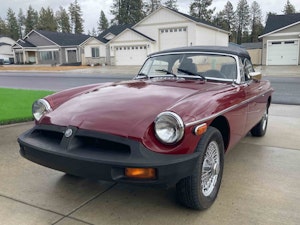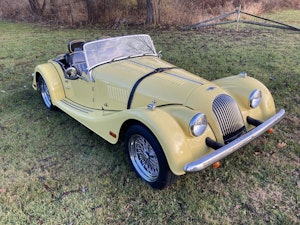Media | Articles
Is This the World’s Best MGB?
The world’s best MGB may not be quite as good as the world’s most average Porsche 911 GT3 with which it shares its $173,000 base price, give or take, but it’s still pretty darn interesting. Especially if you’re tired of Porches and the whole Porsche scene, a subset of enthusiasts that is a key customer source for Frontline Cars, a British company that injects new technology and verve into the poster child of English classics.
Operating just a stone’s throw from the Abingdon-on-Thames site of the original Morris Garage factory near Oxford, England, Frontline builds a sort of super MGB with huge upgrades to both the performance and luxury of the cheap and cheerful original. You might think of it as a Singer-ized MGB, referring to the California company that totally transforms old 911s into megabuck restorods, but Frontline doesn’t go quite that far with the old crates from Abingdon.
Basically, says company founder Tim Fenna, the cars incorporate everything he’s learned about MGs since he began racing them in the 1980s and breaking their gearboxes. He wasn’t the only one destroying them, and what started in 1991 as a small business filling orders for five-speed transmission kits for Sprites and Midgets has evolved into a firm of 18 people who make kits for people wanting to improve their MGs and who also sink 2500 to 3000 hours into building fully realized and bespoke MGB restomods for cashed up clients who want something just a little different.



The company brought two cars to Monterey Car Week that we were able to sample, including a four-cylinder Bespoke Edition roadster with the aforementioned $173,000 price for the U.S., and a new V-8-powered MGB GT called the LE60 that runs $222,500. Both were hugely entertaining to drive though we admit to being partial to the Bespoke Edition, partly because it seemed to hew more closely to what the MGB was originally about.

To build a Bespoke, Frontline starts with a new reproduction MGB roadster body shell produced by British Motor Heritage. It then goes to town with the seam welder, welding up sheet-metal joints to make the shell extremely stiff. Fenna says the inspiration is the ultra-stiff bodies used back in the day by MG’s factory race cars. The door, hood, and trunk gaps are tightened up, and other hand finishing takes place to ensure a perfect paint job.
Marketplace
Buy and sell classics with confidence
Under the hood slips a 2.0-liter Mazda Miata powertrain heavily worked with Frontline’s own ECU, higher-lift cams, a ported and polished head, and a proprietary intake which has individual throttle bodies for each cylinder. The intake manifold takes a week to machine on a CNC mill. The result is a claimed 44-hp jump from the stock 181-horse Miata and an increase in torque of 46 pound-feet, plus a redline increase to 7500 rpm. Frontline also offers a 290-hp “circuit” version with a bored and stroked 2.5-liter that costs, uh, a lot more.




What you hear and feel in the Bespoke is something less Japanese and distinctly more Italian, with a throaty note that rises in pitch as the tach needle swiftly swings around. The six-speed shifts as if lubricated with Land-O-Lakes and the clutch take-up is equally liquid. If MG had had this powertrain in 1965, they would have ruled the world, on track and off.
Underneath, Frontline works the brakes and suspension with discs all around and coil-over shocks front and rear. The revised rear-axle setup harkens back to MG’s racing days in the ‘60s, when the company built five prototypes with an experimental five-link rear suspension. Basically, it replaces the stock leaf springs with coilovers that attach to new subframe elements, four trailing links, and a Panhard rod to stop side-to-side axle motion. Incidentally, Frontline’s bolt-on rear suspension kit is available separately through Moss Motors for $3295, though its effectiveness might be somewhat limited without the accompanying seam welding to stiffen up the body. The MGB “is such a pretty car,” says Fenna, “but it was done in by its dynamics.” All the welding, chassis, and brake work is intended to fix that.

Cars of the period tended to have rather simple and unsupportive seats, so inside are handmade buckets tailored to the customer’s specs. Frontline rolls and beads the sheet-aluminum frames and swaddles it in hide (or whatever you chose as an alternate), all in-house. Power windows and a high-end Morel audio system complement the package.
In a few heated runs over Laureles Grade, which ironically is the only decent driving road anywhere near the events of Monterey Car Week, the Bespoke proved an absolute joy, attacking corners with tight steering and disciplined body control but enough compliance that it absorbs the bumps without upsetting the car. The engine has torque aplenty and pulls hard to the redline with a lovely burr not found in any Miata. The seats are comfortable and the car presents as an uber-cool daily driver that would attract way more attention from all the right people than any modern car at the price. Then again, it doesn’t have backup cameras, lane-keeping warnings, or airbags, if that’s a concern.

We then switched to the V-8-powered LE60 Factory Edition, a car that Fenna acknowledges is still a work in progress. The MGB GT body shell, the only option for the 30 cars planned, is stuffed with a 4.8-liter Rover/Buick V-8 making 375 horses and 312 pound-feet of torque. Fenna says the engine actually slips in pretty easily, as the MGB was designed from the outset for a vee-style engine. Getting at those rear spark plugs, however…
Frontline makes its own cylinder heads and induction system for this old warhorse of a motor, and a five-speed Tremec routes power to a Quaife limited-slip diff. The fully adjustable Nitron shocks are similar to those that are factory fitted to certain Porsche and Lotus models. Six-piston front calipers turn speed into heat, and 16-inch Dunlop-style alloys with knockoff spinners complete the vintage look. Four inches wider than the original B GT, the car weighs a stated 2500 pounds and feels it, launching hard under throttle like a little British NASCAR starter.

All the brute, ear-pinning power of the LE60 means some of the subtlety of the Bespoke is lost; the Tremec takes a firmer grip, the steering is heavier and less stiletto-like, and the car is screwed down tighter, meaning it lands harder over bumps. Still, it rages in a way that no MGB—even the few MGB GTs produced with factory V-8s—was ever capable of. As a track machine, the LE60 would be a barrel of angry monkeys, especially once Fenna and his crew finish fine-tuning the steering and damper rates. As a daily, it would appeal to someone who might otherwise daily something like a Cobra replica.

Fenna says the company has a two-year waiting list, though bits of pieces of the cars are sold separately as kits. However, none of the powertrain equipment is sold separately, mainly because the company thinks it might be dangerous if people bolt Frontline’s 225-horse (or 375-horse) engines into raggedy old MGs with rusty leaf-springs. And unlike with old Porsches, there are still a lot of old MGs out there available for lunch money. Thank heavens.





































































Everyone’s entitled to their opinion, but I think it’s misdirected criticism to compare Frontline’s cars to the originals; they are clearly targeted at a different end-user. Better to think about the Bespoke Edition and LE60 as handmade cars that just happen to resemble MGBs and MGB GTs.
While old British roadsters aren’t my thing, I welcome every Frontline car that displaces a bloated 911 or overpriced Ferrari.
And yeah, about the LE60’s stance: Red Bull’s RB-16 F1 car called; it wants its rake back.
Five or six years ago, my friend Jeff Zurschmeide (former editor in chief of “Forever MX-5”) and I (former lifestyle editor of the same publication) were riding in my ’96 NA Miata. I talked about how I was kind of pining for an MGB-GT, an excellent choice for the weather in Western Oregon. He mentioned he knew of one for sale, a 1967 with overdrive.
“That’s the best MGB ever,” I commented. There was a three-second pause and then we turned to look at each other.
“Oh, who are we kidding?” I said. “We’re IN the best MGB ever made, and we both know it.”
Now, Jeff and I co-drove my EP MGB a couple of times; it had a Butch Gilbert chassis, a 6-point cage, and was probably at least as stiff as these. (My daily was a ’71 MGB at the time.) Jeff still owns his father’s MGA (with an MGB 1.8L now) and about as many cool cars as you’d expect.
These sound wonderful, but as many have said, the money borders on insane. And why they didn’t use the 15″ Minator centre-lock alloys (visual duplicates of the wheels on the John Chatham MGC race cars) will remain a mystery.
One other note from a guy with a brick from the Abingdon factory in the windowsill of my office: it was Ken Costello who first put a Rover V8 into an MGB. Syd Enever and John Thornley decided to add the option to factory MGBs, and all B vody shells built from 1974 had the mods to the radiator and trans tunnel to support it.
Sadly, by the time the MGB-V8 was a factory offering, British Leyland were already, shall we say, deprecating the Abingdon offerings. So they only gave approval to use the 145-bhp “agricultural” V8 rather than the 165-bhp motor from the Rover saloons. Even so, Thornley used one as his company car, and commented that “it pulled like a bloody steam engine.” And considering that, in US trim at least, the 18V engine in 1974-1980 MGBs was rated in the mid-60s (US net bhp), that 145 number looks awfully good.
But as the current owner of a 2L Miata, I would like to hear more about that tune…
People discussing the price fail to understand this product. It will never appear in a “Road & Track” comparison shootout where performance and price are discussed. It’s something altogether different. So many cars today are simply soulless that it makes sense to take something like an MGB and create the best you can make it. Certainly, there are diminishing returns on the costs but that has been a part of automotive history. I say if the car appeals to you and you have the means, go for it. Life is a limited time offer.
If one had lottery money, it would be so fun to own the best possible version of older vehicles, like Factory Five, Legacy Classic Trucks. Velocity, the Jeep Wagoneer recreations from Wagonmaster, Icon 4X4, Eagle Jaguar E-Type, Singer Porsche, Vintage Broncos, Mustangs from Revology, Alphaholics, Classic Restorations, the MG featured here, and many others.
Gorgeous cars, and I will admit I was going to comment on the price; but deep down, its only cause they are out of my league. Would love to own one, or at least take one for a drive.
They should sell that revised Miata engine as a crate engine. I know a few other Miata owners who’d swap out the stock engine for that revised engine.
MY ’80 B LE roadster is kind of a visceral appendage that I love to wear – when it’s behaving. The Frontline B’s seem like out of body experiences that I for one would love to enjoy. Sure, price is a consideration, don’t most decisions consider that factor. But owning a truly Limited Edition (LE) version of the bespoke B engineered by Frontline would add a whole new dimension to the driving experience. I wish Frontline the greatest of success. But the 16″ wheels do look goofy.